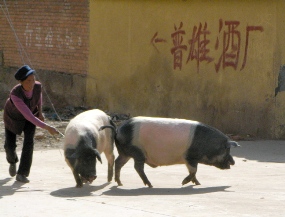China to become dominant force in animal feed market

China is expected to become a dominant force in the world animal feed market according to Bob Swick when speaking to the delegates attending the Australasian Milling Conference in Melbourne recently.
Rising wealth and a change in diet among the Chinese population has resulted in a rapidly expanding meat and aquaculture market. With that has come relentless growth in the animal feed market.
Nutritionist with Singapore company Linden Nutrition, Bob Swick, told the conference China was acquiring companies around the world to ensure there was enough food to feed its people.
"It doesn’t want to see the political problems now being experienced in Thailand," Swick said. Meat consumption in China has outstripped its Asian neighbours.
Steep rise in meat consumption
Chinese meat consumption is now 54kg/capita/year – nearly double the Asian average and just less than half that of the US. Pork remains China’s most popular meat and its consumption has doubled in the past 10 years.
China raises and slaughters more than 700 million pigs a year. But chicken and beef had taken a greater share of the total market during the past two decades.
Chicken consumption accounted for 9% of the total Chinese meat market in 1985, but had risen to 20% by 2008. Beef’s share had jumped from 6% to 14% over the same period.
Much of the slaughtering and meat sales still occurred at roadside and market locations, with refrigeration relatively rare across China.
Room for expansion in feed
NSW-based Ausfarm Nutrition Products general manager Paul Meggison, who spent a number of years working in China, said rising meat consumption meant there were still opportunities for expansion in the compound feed market.
He said the pig feed market was made up of a mix of compound feed, home mixes and swill (food scraps and liquid waste).
Compound feed fed to pigs currently accounted for about 40 million tonnes, but this could rise to about 180 million tonnes as home mixes would gradually scale back and swill would be eliminated under a "safe meat" policy, he said.
Meggison said only 40% of all Chinese meat complied with the "safe meat" policy and this was expected to reach 80% by 2015.
Feed market potential
He estimated the Chinese compound feed market had the potential to reach 275 million tonnes by about 2020-2025, based on "market ceiling" factors. That would be a major share of the global feed market.
Swick said that if the global feed market grew at its current rate of 2%, the world would be producing 750 million tonnes of industrial feed by 2015 – up from its current level of 708 million tonnes.
Corn imports expected
"This will require an additional 20% of grain and oilseed meal, which translates to a yearly global production of 1,168 million tonnes of coarse grain (an additional 195 million tonnes) and 255 million tonnes of oilseed meal (an additional 43 million tonnes) by 2016," he said in his report to the conference.
Swick said China’s feed market grew an incredible 24% last year, stretching the ability of home-grown crops to supply enough grain for manufacture of stockfeeds.
“China may become a net corn importer as early as 2011-12 as demand for livestock feed overtakes China’s internal supplies of corn and more acreage goes to horticultural production."
Source: Weekly Times Now











